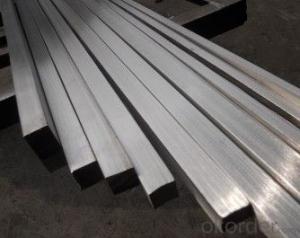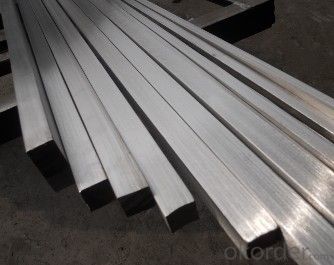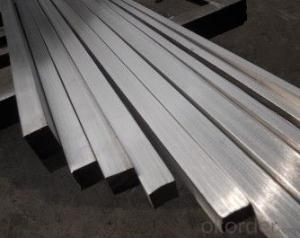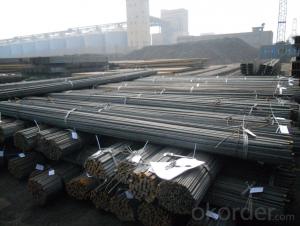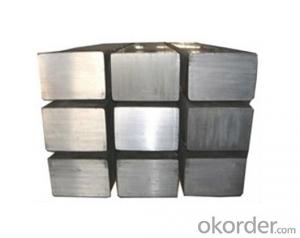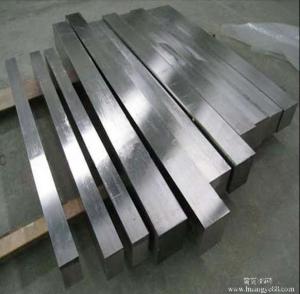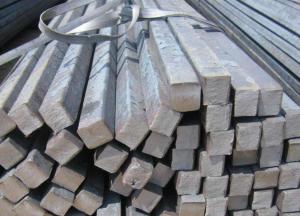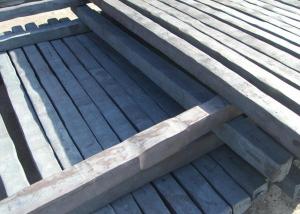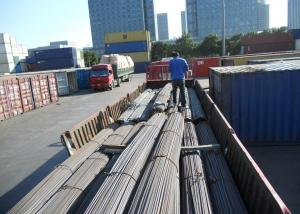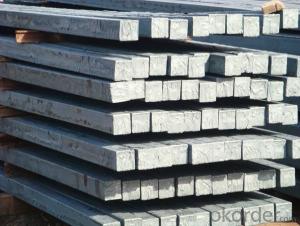16MnSi High Quality Square Steel Bar
- Loading Port:
- Tianjin
- Payment Terms:
- TT OR LC
- Min Order Qty:
- 1000 m.t.
- Supply Capability:
- 100000 m.t./month
OKorder Service Pledge
OKorder Financial Service
You Might Also Like
Product Description:
Product Description:
In the production of steel products, steel is molded and reshaped with different machinery at different temperatures. One process is steel rolling, which involves metal stock passing through a pair of rolls. Rolling produces flat steel sheets of a specific thickness, and the process is classified according to the temperature at which the metal is rolled. If the temperature of the metal is above its recrystallization temperature, or the temperature at which the grain structure of the metal can be altered, then the process is termed as hot rolling. If the temperature of the metal is below its recrystallization temperature, the process is termed as cold rolling.
Like cold rolling, cold drawing is performed at room temperature, but instead of producing a flat object like a coke can, cold drawing makes steel into the form of a wire like the spokes of a wheel or a paper clip. To start the process, Steel is usual hammered and rolled so that it can be fit through a die; a tool that turns the steel mass into a wire. The room temperature steel is pulled through the die which reshapes it into a thinner shape while maintaining the same volume. It is similar to the idea of syrup flowing out of a bottle through a tube in that it changes shape but not volume, but instead of squeezing the metal, it is pulled out. In order to get the wire down to the right diameter, it usually requires more than one pass through different dies.
Colddrawn steel, steel covered carbon steel, excellent carbon steel, alloy structural steel, carbon tool steel, spring steel, bearing steel, tool steel, cold heading steel, free cutting steel, martensite stainless steel; products include all kinds of shapes round, square steel, hexagonal, flat steel and other conventional products, including various special-shaped steel products. In all types of colddrawn steel industry has been widely used, these areas include automotive, machine tools, furniture, standard parts, textile machinery, agricultural machinery, military industry and other industries.
The total assets of more than 40 million, as of the end of 2010 with fixed assets of 34 million, with 60 tons from 5 tons a chain drawing machine 10 sets, horizontal and inverted coiled wire drawing machine 5 sets, steel and plate production line of blasting, high-power ham stove, various straightening machine and cold rolling mill and other major equipment.
Usage/Applications
-The Square Bar is normally used as structure steel.
-Row material for other structure steel like steel angles, channels, I-beams, H-beams, etc…
Packaging & Delivery
-Packing Detail: The products can be packed in bundles by steel wires.
-Marks: We make tag marks and color marks. The tag marks with white background and red company logo will be tied up to each bundle of the products. The information is usually including basic information of products and company and other information requested by customers. As for color marks, we will paint both ends of bundles to make sure that it w
-Delivery Detail: 30~45 working days after receive buyer’s T.T. or L/C.
ill be more convenient for customers to distinguish them from other products.
- Q: How do you use a steel square for leveling tasks?
- A framing square, also commonly referred to as a steel square, possesses great versatility and can be employed for a variety of leveling purposes. Here's a step-by-step guide on utilizing a steel square for leveling: 1. Ascertain the designated area for leveling: Before initiating the usage of a steel square, it is imperative to identify the precise region or surface that necessitates leveling. This could encompass a floor, countertop, shelf, or any other even plane. 2. Cleanse the surface: Ensure that the surface is devoid of any debris or obstructions, guaranteeing the accuracy of the leveling outcomes. 3. Position the steel square onto the surface: Place the steel square onto the surface, ensuring comprehensive coverage of the area that demands leveling. Proper alignment requires the extended side of the square to correspond with the desired leveling direction. 4. Verify for levelness: Employ a bubble level or a level application on your smartphone, positioning it atop the steel square. Adjust the surface until the bubble rests in the center, signifying an optimal state of levelness. 5. Repeat the process if necessary: In the event that the surface is not adequately leveled, make the necessary adjustments. Shims or spacers can be utilized to raise or lower specific regions until the bubble aligns with the center. 6. Conduct a double-check: After implementing the adjustments, reevaluate the levelness to confirm its accuracy. Repeat the process until the surface achieves complete and satisfactory levelness. It is important to bear in mind that while a steel square serves as a beneficial tool for evaluating and leveling surfaces, it may not be suitable for all circumstances. For larger areas or more intricate leveling tasks, supplementary tools or equipment may be required.
- Q: How do you use a steel square to measure and mark 22.5-degree angles?
- To use a steel square to measure and mark a 22.5-degree angle, you need to follow a few simple steps. Firstly, position the steel square so that the long edge (hypotenuse) is facing you, and the shorter edge (leg) is on the left side. Ensure that the right angle formed by the two edges is placed at the starting point of your angle. Next, identify the scale on the leg of the square. This scale usually represents degrees, so find the 45-degree mark on the scale, which is halfway between 0 and 90 degrees. From the 45-degree mark, count two units to the right. Each unit on the scale represents one degree, so counting two units will give us 2 degrees. This is because a 45-degree angle is halfway between 0 and 90 degrees, and half of 45 is 22.5. Once you have identified the 2-degree mark, draw a line using a pencil along the edge of the square that runs through this mark. This line will represent a 22.5-degree angle. To double-check your measurement, you can also measure the angle using a protractor. Place the protractor at the starting point of your angle and align its baseline with the line you drew using the steel square. Ensure that the protractor's zero-degree line aligns with the line from the square, and then confirm that the protractor reads 22.5 degrees. By following these steps, you can accurately measure and mark a 22.5-degree angle using a steel square.
- Q: How do you use a steel square to measure board diagonals at different angles?
- To use a steel square to measure board diagonals at different angles, you would first position the steel square against one corner of the board. Then, align the long side of the square with one edge of the board, ensuring it is firmly in place. Next, extend the short side of the square to the opposite corner of the board, measuring the diagonal distance. To measure the diagonal at a different angle, simply rotate the square accordingly and repeat the process.
- Q: Can a steel square be used for checking the levelness of a workbench top?
- Yes, a steel square can be used to check the levelness of a workbench top. A steel square is a versatile tool that can be used for various measurements and alignments, including checking for levelness. To use a steel square to check the levelness of a workbench top, place the square on different parts of the surface and observe if it rests evenly or if there are any gaps between the square and the workbench top. If the square lays flat on all areas without any gaps, it indicates that the workbench top is level. However, if there are gaps or unevenness, adjustments may be necessary to ensure a level workbench top.
- Q: How do you use a steel square to lay out a jack rafter?
- To use a steel square to lay out a jack rafter, you start by determining the pitch of the roof and the run of the rafter. Then, position the steel square on the rafter stock with the body of the square against the edge. Next, align the pitch mark on the square with the edge of the rafter and mark the plumb cut. Finally, pivot the square to the desired run measurement and mark the seat and birdsmouth cuts.
- Q: Can a steel square be used for welding?
- Indeed, welding can make use of a steel square. A steel square, known for its versatility, is frequently utilized in welding tasks to guarantee precise measurements and right angles. It serves as a guiding tool to thoroughly inspect the alignment and squareness of weld joints, ensuring their proper placement and welding at a 90-degree angle. Moreover, a steel square can be employed to measure and mark materials before cutting or welding, guaranteeing meticulous dimensions. In summary, a steel square plays a vital role in the welding process as it assists in attaining top-notch and precise welds.
- Q: What are some common uses for a steel square in metal fabrication?
- A steel square, which is also known as a framing square or carpenter's square, is commonly used in metal fabrication for a variety of purposes. In metal fabrication, a steel square has several common uses including: 1. Accuracy in measuring and marking metal pieces is achieved with a steel square. It ensures precise angles and lines, which are crucial in metal fabrication. 2. Perfectly square corners are ensured by using a steel square in metal fabrication. This allows for accurate and seamless welding or joining of metal pieces. 3. Checking for flatness in metal sheets or plates is done using a steel square. It helps identify any warping or bending in the metal surface, allowing for corrections before further processing. 4. Layout work, which involves marking and positioning various components before assembly, benefits from the straight edges and angles of a steel square. It helps accurately transfer measurements and create templates for cutting or shaping metal pieces. 5. Drafting and designing metal structures or components often involve using steel squares. They aid in creating precise drawings, accurate calculations, and ensuring the final product meets required specifications. 6. Steel squares have a protractor scale that allows for measuring and marking various angles. This is beneficial in metal fabrication, where specific angles are required for cutting, bending, or welding metal pieces. 7. During the setup of machinery in metal fabrication workshops, steel squares are useful. They help align and position machines, ensuring they are level and accurately placed for optimal performance. Overall, a steel square is an essential tool in metal fabrication, providing accuracy, precision, and versatility in various tasks such as measuring, marking, squaring corners, checking flatness, layout work, drafting, designing, angle measurements, and machinery setup.
- Q: Can a steel square be used for checking the squareness of door jambs?
- Yes, a steel square can be used for checking the squareness of door jambs. A steel square, also known as a framing square or carpenter's square, is a versatile tool commonly used in construction and woodworking. It consists of two arms that meet at a right angle, allowing for accurate measurements and marking of angles. To check the squareness of a door jamb using a steel square, place the longer arm of the square against one side of the jamb and the shorter arm against the adjacent side. Ensure that both arms are flush against the edges of the jamb. Then, observe if the square aligns perfectly with the jamb. If the jamb is square, the square's edges should run parallel to the sides of the jamb. If the square does not align perfectly with the jamb or there is a gap between the square and the jamb, it indicates that the jamb is not perfectly square. This can cause issues with the door installation, including problems with closing, opening, or latching properly. In such cases, adjustments may be necessary to ensure the jamb is square before proceeding with the door installation. In summary, a steel square can be a reliable tool for checking the squareness of door jambs. It allows for quick and accurate measurements, helping ensure a proper door installation.
- Q: Can a steel square be used for checking the alignment of a table saw fence?
- Yes, a steel square can be used for checking the alignment of a table saw fence. A steel square is a versatile tool that is commonly used for checking the squareness and accuracy of various woodworking tools and projects. When it comes to checking the alignment of a table saw fence, a steel square can be placed against the fence and the saw blade to ensure that they are parallel to each other. By using the steel square as a reference, any deviations or misalignments can be easily identified and corrected. It is important to regularly check the alignment of a table saw fence to ensure precise and accurate cuts, and a steel square is a reliable tool for this purpose.
- Q: Can a steel square be used for woodworking joinery?
- Woodworkers can definitely use a steel square for woodworking joinery. Unlike wood or plastic squares, steel squares have certain advantages. They are known for their durability and accuracy, making them reliable for precise measurements and joinery. Their sturdy construction maintains shape over time, ensuring consistent results. When using a steel square for woodworking joinery, it's important to calibrate and align it properly before taking measurements. This can be done by comparing it to a known accurate reference or using a combination square to verify its accuracy. Some woodworkers prefer steel squares for joinery work because they resist warping and damage that can occur with wooden or plastic squares. Steel squares can withstand the pressure and demands of woodworking tasks, making them long-lasting and reliable in the workshop. However, it's worth noting that steel squares are heavier than wooden or plastic squares, which may affect ease of use for some woodworkers. Additionally, steel squares may have sharp edges, so caution should be taken when handling them to avoid injury or damaging the wood. In conclusion, while a steel square may not be the conventional choice for woodworking joinery, it can be used effectively and accurately. Its durability, accuracy, and resistance to warping make it a suitable tool for woodworkers seeking a reliable and long-lasting square.
Send your message to us
16MnSi High Quality Square Steel Bar
- Loading Port:
- Tianjin
- Payment Terms:
- TT OR LC
- Min Order Qty:
- 1000 m.t.
- Supply Capability:
- 100000 m.t./month
OKorder Service Pledge
OKorder Financial Service
Similar products
Hot products
Hot Searches
Related keywords
